ORIF - Bridge plating
1. Principles
Note on illustrations
Throughout this treatment option illustrations of generic fracture patterns are shown, as four different types:
A) Unreduced fracture
B) Reduced fracture
C) Fracture reduced and fixed provisionally
D) Fracture fixed definitively
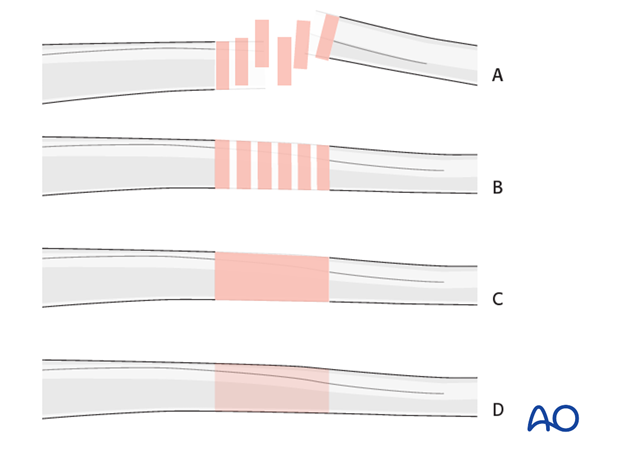
Bridge plating
Bridge plating uses the plate as an extramedullary splint, fixed to the two main fragments, leaving the intermediate fracture zone untouched. Anatomical reduction of intermediate fragments is not necessary. Furthermore, their direct manipulation would risk disturbing their blood supply. If the soft tissue attachments to the fragments are preserved, and the fragments are relatively well aligned, healing is enhanced.
Alignment of the main shaft fragments can be achieved indirectly with the use of traction and the support of indirect reduction tools, or indirectly via the implant.
Mechanical stability, provided by the bridging plate, is adequate for gentle functional rehabilitation and results in satisfactory indirect healing (callus formation). Occasionally, a larger wedge fragment might be approximated to the main fragments with a lag screw.
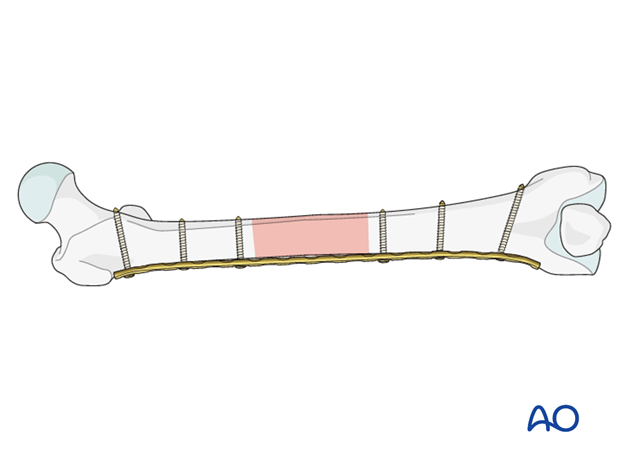
Reduction
It is important to restore axial alignment, length, and rotation.
Reduction can be performed with a single reduction tool (eg, large distractor), or by combining several steps (for example fracture table +/- external fixator, cerclage wiring, +/- reduction via the implant, etc.) to achieve the final reduction.
The preferred method depends on the fracture and soft-tissue injury pattern, the chosen stabilization device, and the experience and skills of the surgeon.
If a large fragment has separated from the fracture zone and impaled the adjacent muscle, direct reduction may be required.
2. Preoperative planning
Plate type
Usually, a broad large fragment plate is chosen.
A locking plate is a good option, especially in osteoporotic bone and for fractures with a short end segment. Such a locking plate need not be contoured to fit the bone precisely since it functions as an internal fixator. Attaching it to the bone does not alter fracture alignment, since the screws do not pull the main bone fragments to the implant.

Regardless of plate type used, the preferred dimension to stabilize femoral midshaft fractures is the 4.5 broad dynamic compression plate (DCP) / limited contact - dynamic compression plate (LC-DCP), or the 4.5 broad locking compression plate (LCP), straight or curved.
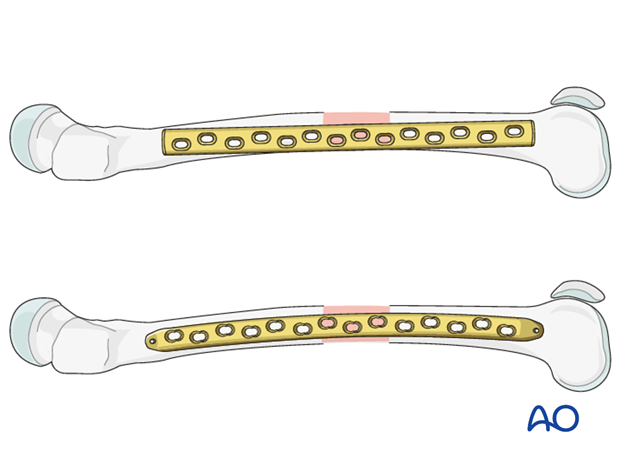
Plate length and number of screws
Generally speaking, the plates for the bridging technique should be longer than for conventional "anatomical" fixations, in order to distribute the forces more widely, as well as to provide relative stability.
Depending on the extent of the zone of fracture comminution and the underlying bone stock (osteoporosis), the appropriate plate length is chosen.
If the fracture location allows, the plate length should be chosen so that six plate holes are over each main fracture fragment.
Sufficient bicortical screws (a minimum of three up to six) should be inserted into each fracture fragment as necessary. The relative stability results from leaving plate holes empty over the fracture zone.
In total, no more than half of the screw holes need to be filled with screws. Remember, that no screws are inserted into the fracture zone.

3. Patient preparation
The patient may be placed in one of the following positions:
4. Approach
For this procedure a lateral approach is used.
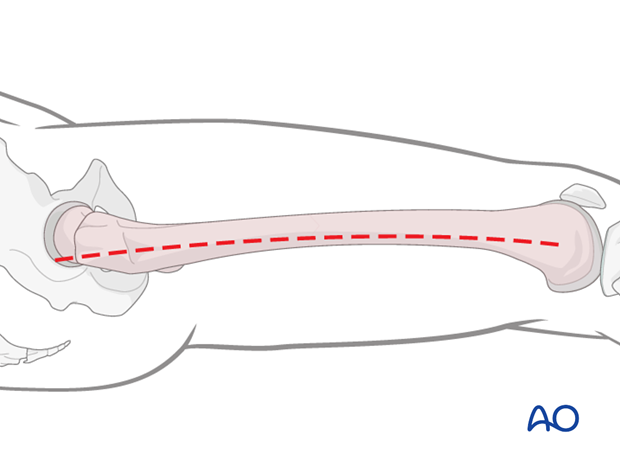
5. Preliminary reduction
Reduction by using a traction table / manual traction
Even in the open procedure, a traction table can be useful to achieve preliminary reduction. Traction applied to the leg restores bone length, realigns the axis and restores tension in the soft tissues. Rotation must be checked carefully.
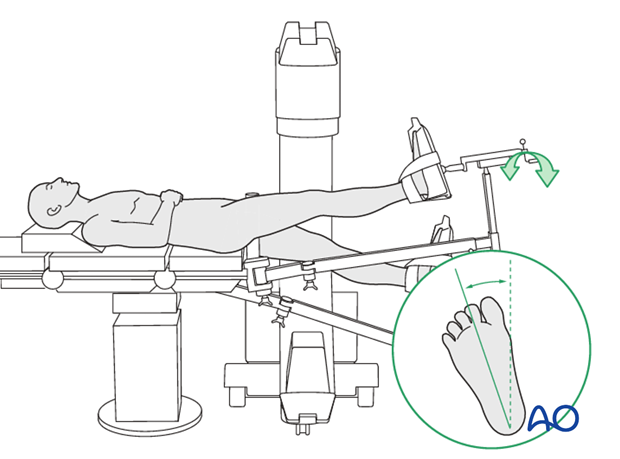
Reduction by external fixator or distractor
Particularly with multifragmentary fractures, the use of an external fixator, or distractor, can provide alignment and stability for bridge plating, without disturbing the soft tissues at the fracture site.
Proximal and distal pins should be inserted carefully in order not to conflict with the later plating procedure. For this purpose, safe positions are anterolaterally, or anteriorly, on the femur.
If no traction table is used, folded linen bolsters under the fracture zone may facilitate reduction.
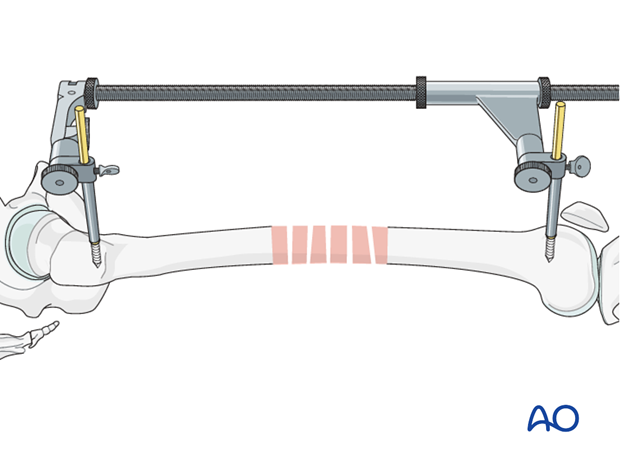
Teaching video
AO teaching video: Application of the large distractor
6. Contouring of the plate
Contouring of the plate over the fracture site is normally not necessary. However, in more proximal and distal fractures it is necessary to contour the ends of a conventional plate to address the anatomy of the proximal and distal femur.
A locking plate does not have to be contoured at all, but to avoid soft tissue irritations, slight contouring may be necessary.
Contouring is easier when performed after provisional reduction has been achieved. For provisional reduction, traction, or a large distractor / external fixator, can be applied.
In the open technique a malleable template is helpful for matching the contours of the proximal and distal segments.
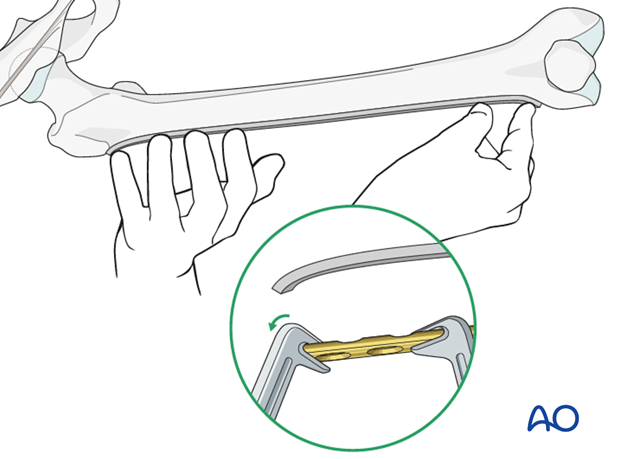
7. Final reduction
Principle
If the preliminary reduction - using for example a traction table - is already optimal with respect to axis, length and rotation, the main fragments are fixed in this position, choosing the optimal screw positions for a bridging technique.

For an optimal outcome, the preliminary reduction frequently needs some final fine adjustment. In those cases, the final fine reduction will be performed, either using the implant, or open reduction techniques.
Nevertheless, even in an open procedure, the stepwise reduction of the fracture towards the implant can be achieved as described in the closed reduction, but in a less challenging open manner.
Next, the open procedure is described using direct reduction techniques.
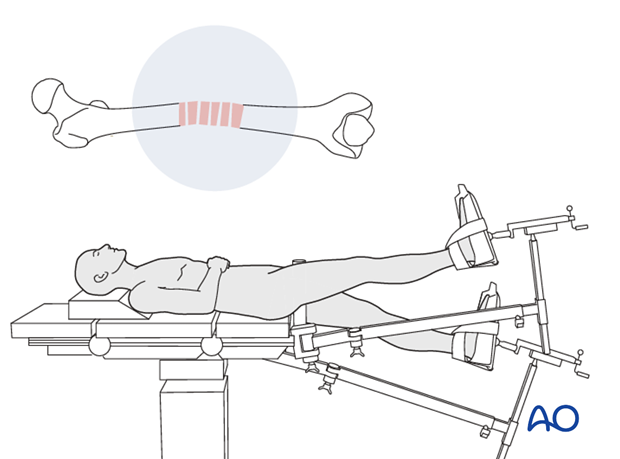
Verbrugge forceps
After exposure of the lateral aspect of the femur, the appropriate contoured plate is held onto the main fragments using Verbrugge forceps.
The longer a fracture zone, the more difficult the evaluation of the correct reduction becomes. In such cases, indirect indicators must be used to assess reduction, especially to check rotation.
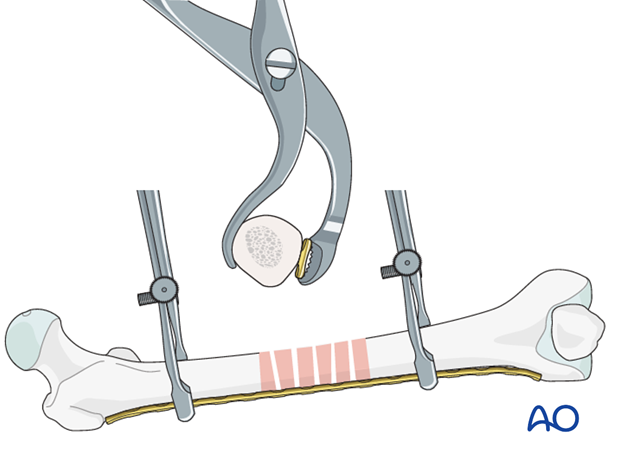
Rotation assessment
To assess rotation, the shape of the lesser trochanter is compared with the contralateral side (lesser trochanter shape sign).
The contralateral leg is then rotated so that its lesser trochanteric profile matches the injured side.
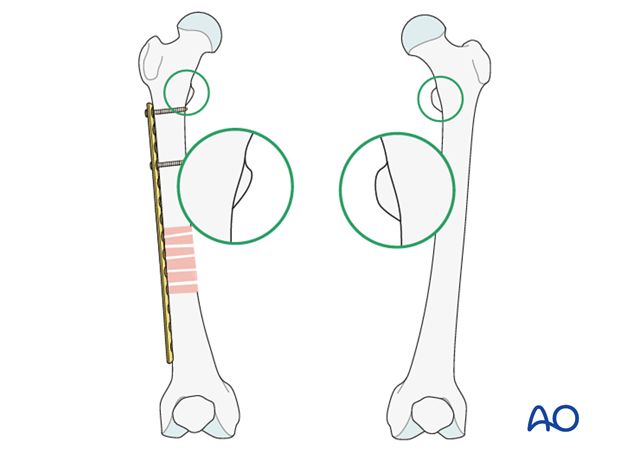
Rotation correction
By rotating the injured leg, either with the traction table or through manual traction, the distal fragment alone is rotated until the patella orientation is similar to that on the uninjured contralateral side. The position of the lesser trochanter must not be changed. This is best done without the plate clamped to the distal fragment.
A K-wire can be applied in the distal most hole to maintain the three dimensional reduction.
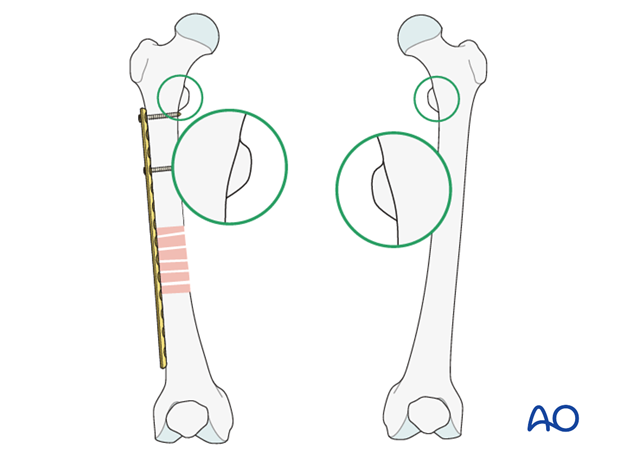
8. Screw placement
Plate fixation
The plate should be fixed to each main fragment with at least three bicortical screws (six cortical holds).

Alternative: If a locking plate (internal fixator) is used, four locking-head screws are inserted into each main fragment. The advantage of an internal fixator is that the plate does not need to be anatomically contoured.
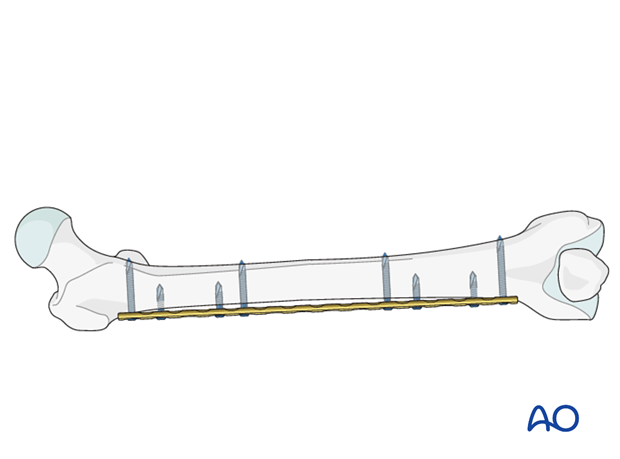
9. Aftercare
Compartment syndrome and nerve injury
Close monitoring of the femoral muscle compartments should be carried out especially during the first 48 hours, in order to rule out compartment syndrome.
Postoperative assessment
In all cases in which radiological control has not been used during the procedure, a check x-ray to determine the correct placement of the implant and fracture reduction should be taken within 24 hours.
Functional treatment
Unless there are other injuries or complications, mobilization may be started on postoperative day 1. Static quadriceps exercises with passive range of motion of the knee should be encouraged. If a continuous passive motion device is used, this must be discontinued at regular intervals for the essential static muscle exercises. Afterwards special emphasis should be placed on active knee and hip movement.
Weight bearing
Full weight bearing may be performed with crutches or a walker.
Follow-up
Wound healing should be assessed regularly within the first two weeks. Subsequently a 6 and 12 week clinical and radiological follow-up is usually made. A longer period may be required if the fracture healing is delayed.
Implant removal
Implant removal is not mandatory and should be discussed with the patient, if there are implant-related symptoms after consolidated fracture healing.













